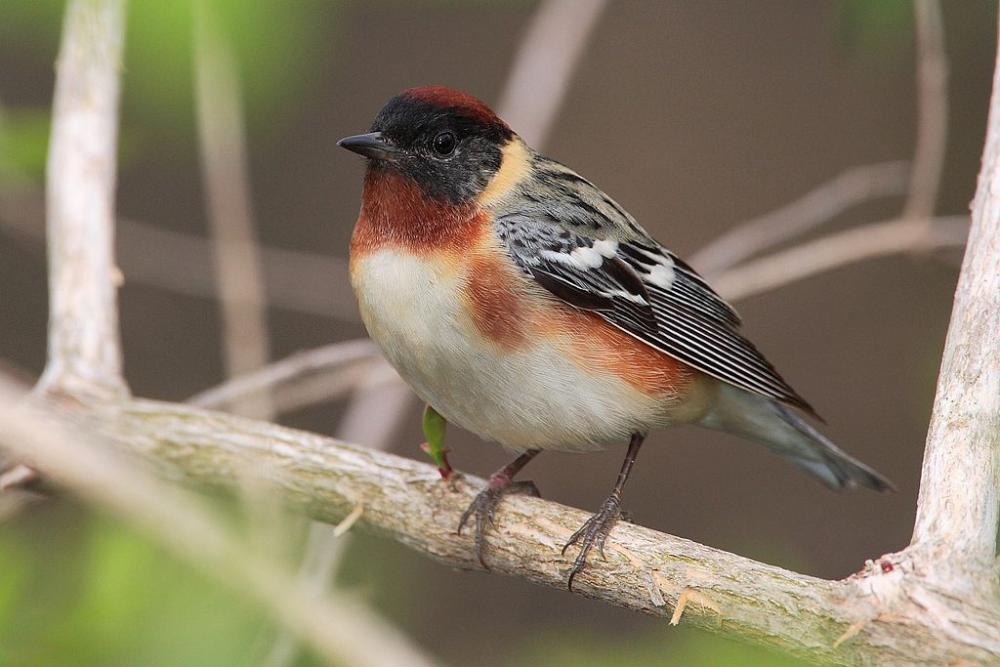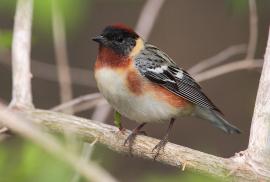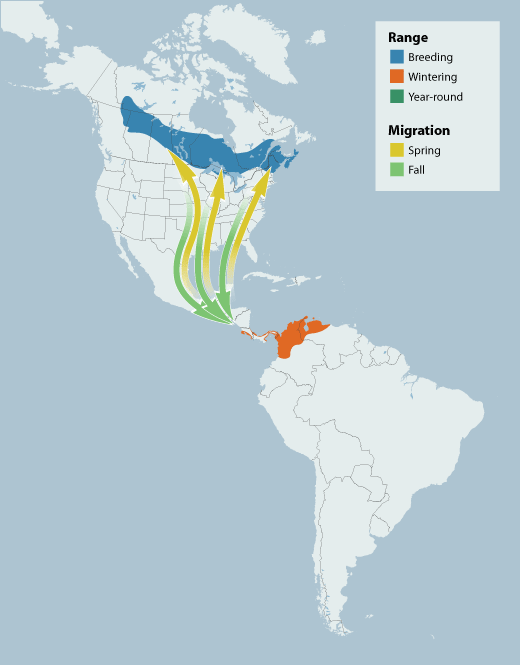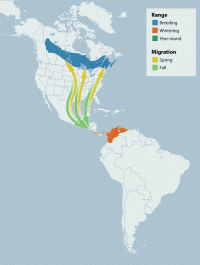Guide to Boreal Birds
This is an in-depth boreal species profile.
What is this?
This species is one of more than 30 birds selected for in-depth profiles. Find out why and see all selected boreal birds »
Overview
Perhaps no bird fits the classic profile of an obscure, boreal-breeding neotropical migrant better than the Bay-breasted Warbler. Breeding mostly in Canada, wintering almost entirely in South America, residing largely in the canopy, and not particularly colorful by warbler standards, it remains unfamiliar to the public and relatively understudied by scientists. This warbler, like the Cape May and Tennessee Warblers, increases in numbers during years of spruce budworm outbreaks in its breeding areas; the excess of food means the warblers are able to produce more young. A handsome bird, it is eagerly sought by enthusiasts during the warbler migrations in middle and late May.
Description
5 1/2" (14 cm). In breeding plumage, male has chestnut cap, throat, and sides; blackish face; conspicuous pale buff patch on side of neck. Upperparts streaked. Females, fall males, and immatures are olive above, with 2 white wing bars; similar to fall Blackpoll Warblers, but with dark legs and often a trace of rust color on flanks.
Voice
A high thin teesi-teesi-teesi-teesi, without change in pitch or volume.
Nesting
5 white eggs, with brown markings, in a loosely built, hair-lined nest of twigs, grass, and needles set in a conifer as much as 50' (15 m) above ground.
Habitat
The Bay-breasted Warbler prefers to nest in mature, low-elevation, dense, boreal spruce-fir forest stands near water. It sometimes uses pine, hemlock, or mixed stands and may be found in bogs or swamps. The species is much less particular during migration, being found in a wide variety of forest types but generally remaining in the canopy. Winter habitat is lowland primary or secondary forest. In some areas, it seems to prefer second-growth to virgin forest; in other areas, the reverse is true; and in still other areas, it shows no obvious preference.
Range/Migration
The Bay-breasted Warbler migrates at night during favorable weather, especially clear nights with a following wind. Adults appear to migrate largely west of the Appalachians, while immatures may follow a more easterly, often coastal, route. Few are encountered in the southern United States, suggesting that most depart at or north of the Carolinas in August and September. After crossing the Gulf of Mexico, these warblers continue overland along the Caribbean slope of Central America, arriving in Panama, Colombia, and Venezuela by November. The species is usually gregarious on the winter grounds, unless food is in short supply, in which case it may defend territories. As is typical of southern-wintering species, spring migration begins relatively late (April) and is hurried, with birds arriving on the breeding grounds within a few weeks. The northward route is similar to the southward, with birds moving up the east coast of Central America and then crossing the Gulf of Mexico. Nearly all movement through the U.S. occurs in late April and May; peak arrival in Canada is during mid- to late May.
Breeding
Eighty-two percent of the global population of Bay-breasted Warbler nests in the boreal forest of North America. The breeding range extends from the southwestern Northwest Territories and northeastern British Columbia to southwestern Newfoundland and northern New England, with an isolated population in the Adirondacks. Relatively little is known of the species' breeding habits. It is assumed to be seasonally monogamous, like most passerines. Males are highly territorial. Breeding densities are much higher in virgin spruce groves than in mixed vegetation and also during spruce budworm outbreaks. The nest is a cup of twigs, bark, grass, lichen, silk, and down lined with rootlets, conifer needles, hair, moss, and grasses. It is built primarily by the female, usually in dense foliage on a low branch. Typically, five eggs are laid; clutch size may be larger in years of plentiful food supply. Incubation is solely by the female and lasts 12 to 13 days. The young fledge at 10 to 11 days of age and are fed for several days thereafter. Independent young may join mixed-species flocks, often with Blackpoll Warblers. This species, like most long-distance migrants, raises only one brood per year. It is sometimes a brood host of the Brown-headed Cowbird (Molothrus ater) in the limited area where both occur.
Diet/Feeding Behavior
As is typical of many small songbirds, this species exhibits a seasonal shift between arthropods and fruits. In summer, the diet is primarily insects and spiders, usually taken from sparsely foliated, inner, midlevel spruce and fir branches and lower dead branches. It is partial to lichen-encrusted areas of branches. This foraging pattern is much like that of the closely related Blackpoll Warbler (D. striata) but the two species typically avoid competition where ranges overlap by nesting at different elevations (Blackpoll higher). The Bay-breasted Warbler capitalizes on budworm and tent caterpillar outbreaks when they occur and may help reduce the frequency of these outbreaks. Its foraging strategy and diet are more flexible during migration, matching the greater range of habitats used; large numbers of berries are eaten at these times. Winter diet is highly seasonal, focusing on arthropods when they are plentiful, typically during the rainy season, and shifting to small fruits during the dry season. This dietary shift may necessitate a habitat shift as well, as the small fruits this species prefers are more plentiful in younger forests.
References
Greenberg, R. 1984. The winter exploitation systems of Bay-breasted and Chestnut-sided Warblers in Panama. Univ. Calif. Publ. Zool. 116:1-107.
Morse, D.H. 1978. Populations of Bay-breasted and Cape May Warblers during an outbreak of the spruce budworm. Wilson Bull. 90:404-413.
Sauer, J.R., J.E. Hines, and J. Fallon. 2003. The North American Breeding Bird Survey, Results and Analysis 1966-2002, Version 2003.1, USGS Patuxent Wildlife Research Center, Laurel, MD.
Credits
Birding content provided by National Wildlife Federation/eNature, with support from Ducks Unlimited/The Pew Charitable Trusts.





